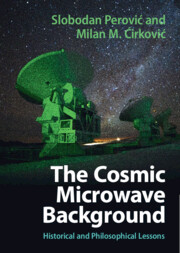Refine search
Actions for selected content:
13581 results in History of science and technology
7 - Oversimplifications
- from Part II - Living with the Bomb
-
- Book:
- Hitler's Atomic Bomb
- Published online:
- 18 July 2024
- Print publication:
- 18 July 2024, pp 147-178
-
- Chapter
- Export citation
Part I - The Bomb
-
- Book:
- Hitler's Atomic Bomb
- Published online:
- 18 July 2024
- Print publication:
- 18 July 2024, pp 3-144
-
- Chapter
- Export citation
Acknowledgments
-
- Book:
- Hitler's Atomic Bomb
- Published online:
- 18 July 2024
- Print publication:
- 18 July 2024, pp x-x
-
- Chapter
- Export citation
Introduction
-
- Book:
- Hitler's Atomic Bomb
- Published online:
- 18 July 2024
- Print publication:
- 18 July 2024, pp 1-2
-
- Chapter
- Export citation
10 - Copenhagen
- from Part II - Living with the Bomb
-
- Book:
- Hitler's Atomic Bomb
- Published online:
- 18 July 2024
- Print publication:
- 18 July 2024, pp 240-267
-
- Chapter
- Export citation
Abbreviations
-
- Book:
- Hitler's Atomic Bomb
- Published online:
- 18 July 2024
- Print publication:
- 18 July 2024, pp xi-xii
-
- Chapter
- Export citation
Figures
-
- Book:
- Hitler's Atomic Bomb
- Published online:
- 18 July 2024
- Print publication:
- 18 July 2024, pp viii-viii
-
- Chapter
- Export citation
4 - Selling Uranium
- from Part I - The Bomb
-
- Book:
- Hitler's Atomic Bomb
- Published online:
- 18 July 2024
- Print publication:
- 18 July 2024, pp 48-76
-
- Chapter
- Export citation

The Cosmic Microwave Background
- Historical and Philosophical Lessons
-
- Published online:
- 09 July 2024
- Print publication:
- 27 June 2024
19 - Hoyle–Narlikar theory and the changing masses origin of the CMB
- from Part V - Radical unorthodoxies: The CMB without the Big Bang
-
- Book:
- The Cosmic Microwave Background
- Published online:
- 09 July 2024
- Print publication:
- 27 June 2024, pp 108-112
-
- Chapter
- Export citation
22 - CMB in plasma cosmology
- from Part V - Radical unorthodoxies: The CMB without the Big Bang
-
- Book:
- The Cosmic Microwave Background
- Published online:
- 09 July 2024
- Print publication:
- 27 June 2024, pp 124-125
-
- Chapter
- Export citation
10 - Classifying and analyzing unorthodoxies
- from Part III - What constitutes an unorthodoxy? An epistemological framework of cosmology
-
- Book:
- The Cosmic Microwave Background
- Published online:
- 09 July 2024
- Print publication:
- 27 June 2024, pp 57-60
-
- Chapter
- Export citation
31 - The CMB and the multiverse
- from Part VII - Other philosophically relevant aspects of the CMB
-
- Book:
- The Cosmic Microwave Background
- Published online:
- 09 July 2024
- Print publication:
- 27 June 2024, pp 164-167
-
- Chapter
- Export citation
Epigraph
-
- Book:
- The Cosmic Microwave Background
- Published online:
- 09 July 2024
- Print publication:
- 27 June 2024, pp v-vi
-
- Chapter
- Export citation
Part VI - Formation of the orthodoxy and the alternatives: Epistemological lessons
-
- Book:
- The Cosmic Microwave Background
- Published online:
- 09 July 2024
- Print publication:
- 27 June 2024, pp 129-152
-
- Chapter
- Export citation
Notes
-
- Book:
- The Cosmic Microwave Background
- Published online:
- 09 July 2024
- Print publication:
- 27 June 2024, pp 177-184
-
- Chapter
- Export citation
Introduction
-
- Book:
- The Cosmic Microwave Background
- Published online:
- 09 July 2024
- Print publication:
- 27 June 2024, pp 1-4
-
- Chapter
- Export citation
1 - Physical cosmology from Einstein to 1965
- from Part I - Physical cosmology: A brief introduction
-
- Book:
- The Cosmic Microwave Background
- Published online:
- 09 July 2024
- Print publication:
- 27 June 2024, pp 7-8
-
- Chapter
- Export citation
3 - Hot Big Bang and λCDM
- from Part I - Physical cosmology: A brief introduction
-
- Book:
- The Cosmic Microwave Background
- Published online:
- 09 July 2024
- Print publication:
- 27 June 2024, pp 13-16
-
- Chapter
- Export citation
Part II - Discovery of the CMB and current cosmological orthodoxy
-
- Book:
- The Cosmic Microwave Background
- Published online:
- 09 July 2024
- Print publication:
- 27 June 2024, pp 17-38
-
- Chapter
- Export citation
